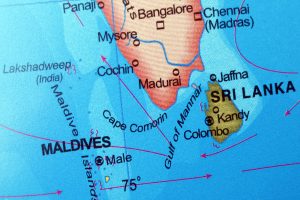Two high-profile visits earlier this month — one by Indian External Affairs Minister S. Jaishankar to Colombo on October 4, and the other by Maldives President Dr. Mohamed Muizzu to New Delhi on October 7 — have once again brought a focus on New Delhi’s neighborhood diplomacy.
New Delhi seems to be shifting focus to maritime engagements with littoral nations. In a departure from the past, the contours and geographic scope of India’s maritime security are broadening, which is now emerging as an important aspect of India’s Neighborhood First policy. Under the aegis of the Modi government’s SAGAR initiative, visits between India and countries in its oceanic neighborhood have become more frequent. Following bilateral talks between Muizzu and Modi, the leaders unveiled “A Vision for Comprehensive Economic and Maritime Security Partnership,” which is described as “people-centric, future-oriented, and… an anchor of stability in the Indian Ocean Region.”
In Sri Lanka, Jaishankar offered a $61.5 million grant to modernize the Kankesanthurai port in northern Sri Lanka. In an earlier visit to Sri Lanka in June this year, both sides unveiled the Maritime Rescue Coordination Center under a $6 million grant to boost maritime security in the Indian Ocean. New Delhi is focusing on frequent high-level visits, port visits, providing defense supplies and equipment to help countries in the region, capacity building, and greater economic cooperation.
India’s strategic focus has long been on its continental borders, resulting in a neglect of the maritime domain. The strategic inertia toward the Indian Ocean came from the lack of direct competition and a certain degree of complacency as New Delhi had already established itself as a key partner for most of its neighbors in the Indian Ocean. New Delhi’s renewed focus on the Indian Ocean is largely motivated by the growing Chinese strategic footprint in the Indian Ocean. The People’s Liberation Army Navy (PLAN) is rapidly expanding its presence in the Indian Ocean through port and ship deployments and proliferation of submarines and underwater drones. New Delhi has repeatedly expressed its discomfort at the stationing of Chinese ships in its neighboring maritime countries due to concerns over their “surveillance activity.”
Much to New Delhi’s dismay, activities by Chinese research vessels have continued unabated. Just a few days after Jaishankar’s visit, Colombo allowed a Chinese navy ship to dock, despite a one-year ban on Chinese research vessels, on the grounds that it was a “training vessel and not a research craft.”
In addition to its military presence, Beijing has invested heavily in strategic overseas ports in Pakistan, Sri Lanka, Bangladesh, and Myanmar. Domestically, New Delhi’s response has been to build the Indian Navy’s defense capability, particularly its sub-surface fleet, to bolster its presence in the region. Externally, while India has been enhancing extra-regional partnerships with like-minded partners, it remains wary of a large extra-regional presence in littoral South Asia. Therefore, New Delhi’s Indian Ocean diplomacy is rooted more in its immediate neighborhood, with the SAGAR vision focused on advancing cooperation and using its capabilities to benefit all in the region.
India’s renewed outreach toward its Indian Ocean neighbors comes at a time when disputes between China and its neighbors in the South China Sea, notably the Philippines and Vietnam, have intensified. China’s maritime ambitions can be understood as those in the near seas (the South China Sea and the East China Sea) and those in the far seas, the Indian Ocean and beyond. In the near seas, China is more concerned with the militarized territorial disputes that concern its sovereignty, while in the far seas, Beijing is looking to expand its influence. Currently, Beijing’s military and diplomatic energy is occupied in the South China Sea, leaving open space for New Delhi to (re)engage with its maritime neighbors to (re)build influence.
For New Delhi to ensure that the Indian Ocean remains “India’s Ocean,” the SAGAR vision must work in tandem with the Neighborhood First policy. In the short term, India can turn to benign maritime engagements and broad-based cooperation on maritime security to safeguard its own national interest and promote stability in the larger Indo-Pacific region.
































